Early American Cultures (original) (raw)
Early Americas The pre-history of the Americas seems comparatively short in terms of human activity, but small windows of opportunity to view events can be gained through archaeology. Masses of material are found each year by archaeologists, and a system was long ago needed to help organise all these findings.  The system which has evolved to catalogue the various archaeological expressions of human progress is one which involves cultures. For well over a century, archaeological cultures have remained the framework for global prehistory. The earliest cultures which emerge from Africa are perhaps the easiest to catalogue, right up until human expansion reaches the Americas. The task of cataloguing that vast range of human cultures is covered in the related feature (see link, right). Archaeological cultures remain the framework for global prehistory. The earliest migrations into the 'New World' of the Americas seem to have begun between 40,000 and 15,000 years ago. These first arrivals made the most of the Bering land bridge which joined Asia to North America during the most recent ice age. Elements of modern Native American society prefers to propose that they have always been living in the New World and that a migration simply did not take place, while academia hotly contests the proposed dates for the first arrivals. In fact it is quite clear that there was not one long migration but several, perhaps hundreds, each depositing small groups of new arrivals, and with units arriving comparatively late, possibly including the Sumnaginsk people of Siberia. However, the starting point for these many migrations may have been what is now northern-western Canada, from one or more small populations which made the journey across the Bering Straits and then incubated there for several thousand years (see 22,000 BC, below). The anthropologist Douglas C Wallace has studied modern human habitation of Africa over a period which covers more than the last hundred thousand years to the very origins of anatomically modern humans. His studies in relation to migration into the Americas are backed up by DNA evidence which proposes not a land bridge migration but a seaborne movement from south-east Asia. The scene he reconstructs depicts groups of prehistoric, intrepid seafarers moving not out of Siberia, as has long been assumed, but across the Pacific Ocean to reach the Americas around 12,000 to 6,000 years ago. Doubtless this is one possibility for many of the later migrations, and it would make many American Indians distant cousins of the Polynesians. DNA evidence, though, strongly links the majority of native Americans to Siberian and East Asian populations of the Asian Palaeolithic. The earliest cultures of the Americas are perhaps the easiest to catalogue. They include the near-universally widespread Palaeo-Indian era and the Clovis culture. These are especially interesting as they chart human progress after around 25,000 BC, roughly around the time at which the most recent ice age was building to a peak (very severely in Europe and less so in the Near East, Central Asia, early China, early Japan, and even Siberia). The system which has evolved to catalogue the various archaeological expressions of human progress is one which involves cultures. For well over a century, archaeological cultures have remained the framework for global prehistory. The earliest cultures which emerge from Africa are perhaps the easiest to catalogue, right up until human expansion reaches the Americas. The task of cataloguing that vast range of human cultures is covered in the related feature (see link, right). Archaeological cultures remain the framework for global prehistory. The earliest migrations into the 'New World' of the Americas seem to have begun between 40,000 and 15,000 years ago. These first arrivals made the most of the Bering land bridge which joined Asia to North America during the most recent ice age. Elements of modern Native American society prefers to propose that they have always been living in the New World and that a migration simply did not take place, while academia hotly contests the proposed dates for the first arrivals. In fact it is quite clear that there was not one long migration but several, perhaps hundreds, each depositing small groups of new arrivals, and with units arriving comparatively late, possibly including the Sumnaginsk people of Siberia. However, the starting point for these many migrations may have been what is now northern-western Canada, from one or more small populations which made the journey across the Bering Straits and then incubated there for several thousand years (see 22,000 BC, below). The anthropologist Douglas C Wallace has studied modern human habitation of Africa over a period which covers more than the last hundred thousand years to the very origins of anatomically modern humans. His studies in relation to migration into the Americas are backed up by DNA evidence which proposes not a land bridge migration but a seaborne movement from south-east Asia. The scene he reconstructs depicts groups of prehistoric, intrepid seafarers moving not out of Siberia, as has long been assumed, but across the Pacific Ocean to reach the Americas around 12,000 to 6,000 years ago. Doubtless this is one possibility for many of the later migrations, and it would make many American Indians distant cousins of the Polynesians. DNA evidence, though, strongly links the majority of native Americans to Siberian and East Asian populations of the Asian Palaeolithic. The earliest cultures of the Americas are perhaps the easiest to catalogue. They include the near-universally widespread Palaeo-Indian era and the Clovis culture. These are especially interesting as they chart human progress after around 25,000 BC, roughly around the time at which the most recent ice age was building to a peak (very severely in Europe and less so in the Near East, Central Asia, early China, early Japan, and even Siberia).  Humans in the Americas had no cultural competition except from other humans, provided of course that they could survive another fifteen thousand years of ice age (see the 'Prehistoric World' index for information on pre-modern human Earth, via the link on the right). Later human cultures were generally more specific either to North America, Central America, or South America. Humans in the Americas had no cultural competition except from other humans, provided of course that they could survive another fifteen thousand years of ice age (see the 'Prehistoric World' index for information on pre-modern human Earth, via the link on the right). Later human cultures were generally more specific either to North America, Central America, or South America. |
|
|---|---|
 |
|
| (Information by Peter Kessler, with additional information by Edward Dawson, from A Genetic Signal of Central European Celtic Ancestry, David K Faux, from Investigating Archaeological Cultures: Material Culture, Variability, and Transmission, Benjamin W Roberts & Marc Vander Linden (Eds), and from External Link: Humans in America (Phys.org).) | |
| c.128,000 BC | Dating for mastodon remains found in southern California seemingly shatters the timeline for human migration into the Americas, pushing the presence of hominins (not anatomically modern humans) back to 130,000 years ago. The teeth and bones of an elephant-like creature which are unmistakably modified by human-like hands, along with stone hammers and anvils, leave no doubt that a species of early human has feasted on its carcass. [  ](../FeaturesAfrica/HominidChronology4.htm#Homo erectus)The identity of this species of human is not known, but the most likely candidates include Homo denisovan, Homo erectus - prolific in Asia from around 1.8 million years ago - and, less likely, Homo sapiens (archaic) (see feature link to start with the earliest of these). ](../FeaturesAfrica/HominidChronology4.htm#Homo erectus)The identity of this species of human is not known, but the most likely candidates include Homo denisovan, Homo erectus - prolific in Asia from around 1.8 million years ago - and, less likely, Homo sapiens (archaic) (see feature link to start with the earliest of these). 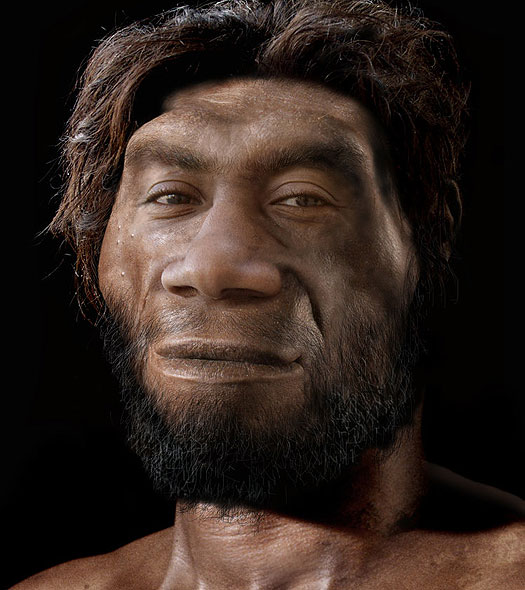 A Homo erectus male as recreated by palaeo-artist John Gurche, representing possibly the most likely candidate for the first ancient human type to have entered the Americas A Homo erectus male as recreated by palaeo-artist John Gurche, representing possibly the most likely candidate for the first ancient human type to have entered the Americas |
| c.50,000 BC |  The dimensions of prehistoric skulls which are found by archaeologists in Brazil match those of the aboriginal peoples of Australia and Melanesia. The site is at Serra Da Capivara in remote north-eastern Brazil, where cave paintings provide the first clue to the existence of these people (see feature link). These people could reach South America as far back as 50,000 BC, with their arrival most likely due to their ocean-going vessel being blown off course. The 'official' dates (or, more realistically, the generally-accepted dates) for the Palaeo-Indian period see it start around 40,000 BC. The dimensions of prehistoric skulls which are found by archaeologists in Brazil match those of the aboriginal peoples of Australia and Melanesia. The site is at Serra Da Capivara in remote north-eastern Brazil, where cave paintings provide the first clue to the existence of these people (see feature link). These people could reach South America as far back as 50,000 BC, with their arrival most likely due to their ocean-going vessel being blown off course. The 'official' dates (or, more realistically, the generally-accepted dates) for the Palaeo-Indian period see it start around 40,000 BC. |
 |
| | |
| ------------------------------------------------------------------------------------------------------------------------------------------------------------------------------------------------------------------------------------------------------------------------------------------------------------------------------------------------------------------------------------------------------------------------------------------------------------------------------------------------------------------------------------------------------------------------------------------------------------------------------------------------------------------------------------------------------------------------------------------------------------------------------------------------------------------------------------------------------------------------------------------------------------------------------------------------------------------------------------------------------------------------------------------------------------------------------------------------------------------------------------------------------------------------------------------------------------------------------------------------------------------------------------------------------------------------------------------------------------------------------------------------------------------------------------------------------------------------------------------------------------------------------------------------------------------------------------------------------------------------------------------------------------------------------------------------------------------------------ |
| EARLY CULTURES INDEX |
| 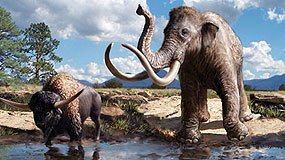 Clovis Culture (c.11,500 - 10,900 BC) Until comparatively recently the Clovis people were thought by many to have been the first to appear in the Americas, but recent finds have removed this title.
Clovis Culture (c.11,500 - 10,900 BC) Until comparatively recently the Clovis people were thought by many to have been the first to appear in the Americas, but recent finds have removed this title. 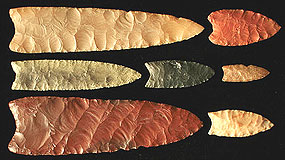 Western Fluted Point (c.11,200 - 9000 BC) Initially believed to have derived from the Clovis, this tradition is now thought to be part of a west coast practice which at first was hemmed in by the Rocky Mountains.
Western Fluted Point (c.11,200 - 9000 BC) Initially believed to have derived from the Clovis, this tradition is now thought to be part of a west coast practice which at first was hemmed in by the Rocky Mountains. 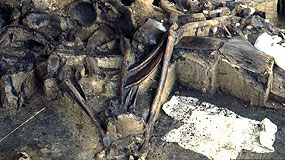 Western Stemmed (c.11,200 - 9000 BC) Another formerly Clovis tradition which has been hived off thanks to further study, this was also hemmed in by the Rocky Mountains, but over much greater territory.
Western Stemmed (c.11,200 - 9000 BC) Another formerly Clovis tradition which has been hived off thanks to further study, this was also hemmed in by the Rocky Mountains, but over much greater territory. 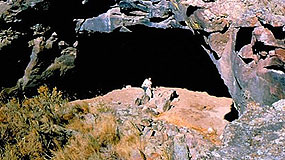 Folsom / Lindenmeier (c.9000 - 8000 BC) The Folsom / Lindenmeier was located across the Great Plains of western North America, in time extending eastwards of the Mississippi into the Great Lakes.
Folsom / Lindenmeier (c.9000 - 8000 BC) The Folsom / Lindenmeier was located across the Great Plains of western North America, in time extending eastwards of the Mississippi into the Great Lakes. 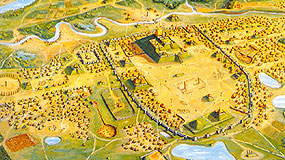 North America Cultures (AD 600) The end of the long Palaeo-Indian era witnessed more regionalised cultures beginning to emerge, with some notable mound-building examples in North America. |
| |
North America Cultures (AD 600) The end of the long Palaeo-Indian era witnessed more regionalised cultures beginning to emerge, with some notable mound-building examples in North America. |
| |